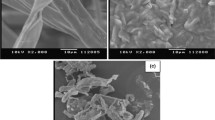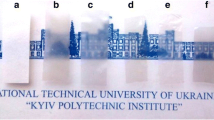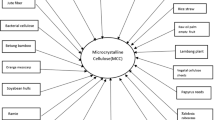Abstract
Microcrystalline cellulose (MCC) particles are mostly prepared by acid hydrolysis of various agro sources. Acid hydrolysis is usually carried out with high concentration (64 wt%) of sulfuric acid. Here, an attempt has been made to optimize lower acid concentrations which can effectively produce MCC particles. In this work, different concentrations of sulfuric acid (20, 30, 35, 40, 47 and 64 wt%) have been used to prepare MCC particles, which have been characterized by XRD, particle size analysis, scanning electron microscopy, transmission electron microscopy, nanoindentation and thermogravimetric analysis. MCC prepared with 35 and 47% sulfuric acid (MCC 35 and MCC 47) had finest particle size and fibrils were produced in the range of 15–25 nm. MCC 20 showed wide particle size distribution, indicating low breakdown of the cellulose chains. The energy absorption behavior and mechanical properties of the MCC pellets were determined by nanoindentation test for the first time. MCC 35 pellets exhibited lowest modulus and hardness.










Similar content being viewed by others
References
Angle`s MN, Dufresne A (2000) Plasticized starch/tunicin whiskers nanocomposites. 1. structural analysis. Macromolecules 33:8344–8353
Bhatnagar A, Sain M (2005) Processing of cellulose nanofiber-reinforced composites. J Reinf Plast Compos 24(12):1259–1268
Bondeson D, Mathew AP, Oksman K (2006) Optimization of the isolation of nanocrystals from microcrystalline cellulose by acid hydrolysis. Cellulose 13:171–180
Cao X, Chen Y, Chang PR, Muir AD, Falk G (2008) Strach-based nanocomposites reinforced with flax cellulose nanocrystals. eXPRESS Polym Lett 2:502–510
Chakraborty A, Sain M, Holzforschung MK (2005) Cellulose microfibrils: a novel method of preparation using high shear refining and cryocrushing. Cat Inst 59:102–107
Chakraborty A, Sain M, Kortschot M, Cutler S (2007) Dispersion of wood microfibers in a matrix of thermoplastic starch and starch-polylactic acid blend. J Biobased Mater Bioenergy 1:71–77
Choi Y, Simonsen J (2006) Cellulose nanocrystal-filled carboxymethyl cellulose nanocomposites. J Nanosci Nanotechnol 6(3):633–639
Dong X, Kimura T, Revol J, Gray GD (1996) Effects of ionic strength on the isotropic-chiral nematic phase transition of suspensions of cellulose crystallites. Langmuir 12:2076–2082
El-Sakhawy M, Hassan ML (2007) Physical and mechanical properties of microcrystalline cellulose prepared from agricultural residues. Carbohydr Polym 67:1–10
Habibi Y, Dufresne A (2008) Highly filled bionanocomposites from functionalized polysaccharide nanocrystals. Biomacromolecules 9:1974–1980
Henriksson M, Berglund LA, Isaksson P, Lindstrom T, Nishino T (2008) Cellulose nanopaper structures of high toughness. Biomacromolecules 9:1579–1585
Iwamoto S, Abe K, Yano H (2008) The Effect of hemicelluloses on wood pulp nanofibrillation and nanofiber network characteristics. Biomacromolecules 9:1022–1026
Klemm D, Philipp B, Heinz T, Heinz U (2004) Comprehensive cellulose chemistry. In: Wagenknecht W (ed) Fundamental and analytical methods, vol 1. Wiley-VCH publication, Weinheim
Lu Y, Weng L, Cao X (2005) Biocomposites of plasticized starch reinforced with cellulose crystallites from cottonseed linter. Macromol Biosci 5:1101–1107
Lu Y, Weng L, Cao X (2006) Morphological, thermal and mechanical properties of ramie crystallites-reinforced plasticized starch biocomposites. Carbohydr Polym 63:198–204
Mathew AP, Dufresne A (2002) Morphological Investigation of nanocomposites from sorbitol plasticized starch and tunicin whiskers. Biomacromolecles 3:609–617
Paul SN, Piasta D, Spange S, Pothan LA, Thomas S, Bellmann C (2008) Solvatochromic and Electrokinetic studies of banana fibrils prepared from steam-exploded banana fiber. Biomacromolecules 9:1802–1810
Revol JF, Dietrich A, Goring DAI (1987) Effect of mercerization on the crystallite size and crystallinity index in cellulose from different sources. Can J Chem 65:1724–1725
Samir MASA, Alloin F, Paillet M, Dufresne A (2004) Tangling effect in fibrillated cellulose reinforced nanocomposites. Macromolecules 37:4313–4316
Schniewind AP (ed) (1989) Concise encyclopedia of wood and wood based materials, 1st edn. Pergamon Press, Elmsford, NY, pp 271–273. books.google.co.in/books?isbn=081382446X
Shlieout G, Arnold K, Muller G (2002) Powder and mechanical properties of microcrystalline cellulose with different degree of polymerization. AAPS PharmScitech 3(2):1–10 (article 11)
Tang LG, Hon David NS, Pan SH, Zhu YQ, Wang Zhen W, Zhen Z (1996) Evaluation of microcrystalline cellulose. I: changes in ultrastructural characteristics during preliminary acid hydrolysis. J Appl Polym Sci 59:483–488
Xiang Q, Lee YY, Pettersson Par O, Torget RW (2003) Heterogeneous aspects of acid hydrolysis of alpha cellulose. Appl Biochem Biotechnol 105–108:505–513
Acknowledgments
Dipa Ray is thankful to AICTE (All India Council for Technical Education), Government of India, for granting her a project. Authors are grateful to Dr. P. C. Basu (Director, Petrology Division) and Ms. Kaberi Banerjee of Geological Survey of India, Kolkata, for their kind support in doing the particle size analysis. Dr. Sabyasachi Som and Mr. U. Kundu are gratefully acknowledged for their support in doing SEM analysis. Authors are also thankful to Mr. Shailendranath Dey of Indian Institute of Chemical Biology (IICB), Kolkata, India, for his help in doing the TEM analysis. Mr. Arijit Sinha (Research Scholar of BESU, Shibpur, Howrah) is also thankfully acknowledged for doing the Nanoindentation test. Authors Mohanty and Misra are thankful to the 2008 University of Guelph/OMAFRA Bioproducts research project for partial support of this research.
Author information
Authors and Affiliations
Corresponding author
Rights and permissions
About this article
Cite this article
Das, K., Ray, D., Bandyopadhyay, N.R. et al. A study of the mechanical, thermal and morphological properties of microcrystalline cellulose particles prepared from cotton slivers using different acid concentrations. Cellulose 16, 783–793 (2009). https://doi.org/10.1007/s10570-009-9280-6
Received:
Accepted:
Published:
Issue Date:
DOI: https://doi.org/10.1007/s10570-009-9280-6




